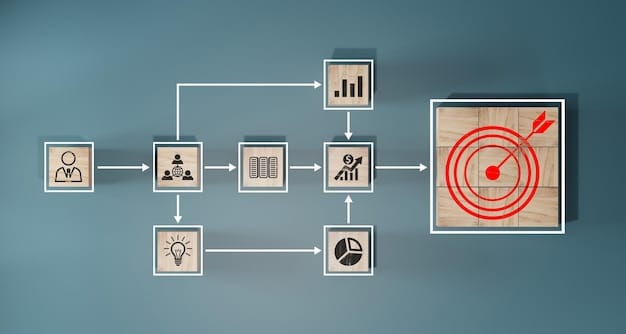Creating a Seamless Omnichannel Customer Experience: Integration Best Practices

Creating a seamless omnichannel customer experience involves integrating various channels to provide a consistent and unified brand interaction, enhancing customer satisfaction and loyalty by meeting their needs across all touchpoints.
In today’s customer-centric world, providing a consistent and unified experience across all channels is crucial for business success. Creating a seamless omnichannel customer experience: best practices for integration involves connecting various touchpoints to ensure customers receive a consistent brand experience, regardless of how they interact with the company.
Understanding the Core of Omnichannel Customer Experience
To truly grasp the significance of a seamless omnichannel experience, it’s essential to understand what it entails. Omnichannel isn’t merely about being present on multiple channels; it’s about ensuring these channels work together harmoniously to provide a consistent and unified customer journey. This approach enhances customer satisfaction, builds loyalty, and ultimately drives revenue growth.
The core of omnichannel lies in recognizing that customers often switch between different channels during their interaction with a brand. A customer might start by browsing products on a mobile app, then call customer service for more information, and finally make a purchase in a physical store. A seamless omnichannel experience ensures that the customer’s journey is smooth and uninterrupted, regardless of the channel they use at any given point.

Key Components of an Omnichannel Strategy
An effective omnichannel strategy involves several key components that work together to create a unified customer experience:
* **Unified Customer Data:** Centralizing customer data from all channels allows for a comprehensive view of each customer’s preferences, behaviors, and purchase history.
* **Consistent Branding:** Maintaining a consistent brand voice, visual identity, and messaging across all channels reinforces brand recognition and builds trust.
* **Integrated Technology:** Implementing technology solutions that enable seamless data sharing and communication between channels is crucial for providing personalized experiences.
* **Personalized Communication:** Tailoring communication to each customer based on their individual needs and preferences enhances engagement and drives conversions.
Benefits of a Seamless Omnichannel Experience
Implementing a well-integrated omnichannel strategy offers numerous benefits for businesses:
* Increased Customer Loyalty: Providing a consistent and personalized experience across all channels fosters customer loyalty and reduces churn.
* Higher Customer Lifetime Value: Engaged and loyal customers are more likely to make repeat purchases and spend more over time.
* Improved Customer Satisfaction: Meeting customer needs and expectations across all touchpoints leads to higher satisfaction levels.
* Enhanced Brand Reputation: Delivering a seamless and exceptional experience enhances brand reputation and attracts new customers.
In conclusion, creating a seamless omnichannel customer experience requires a deep understanding of customer behavior, integrated technology, and a commitment to providing consistent and personalized interactions across all channels. By prioritizing these elements, businesses can build stronger relationships with their customers and achieve sustainable growth.
Aligning Your Business Goals with Omnichannel Integration
Before diving into the technical aspects of omnichannel integration, it’s essential to align your business goals with your omnichannel strategy. This ensures that your efforts are focused and contribute directly to achieving your overall objectives. Clearly defined goals provide a roadmap for your omnichannel journey, guiding your decisions and ensuring that you are delivering value to both your customers and your business.
Aligning business goals with omnichannel integration begins with identifying your primary objectives. Are you looking to increase customer retention, drive revenue growth, improve customer satisfaction, or enhance brand awareness? Once you have a clear understanding of your goals, you can tailor your omnichannel strategy to support these objectives.

Identifying Key Performance Indicators (KPIs)
To measure the success of your omnichannel initiatives, it’s crucial to identify key performance indicators (KPIs) that align with your business goals. These metrics provide valuable insights into the effectiveness of your strategy and allow you to make data-driven decisions to optimize your efforts.
Here are some common KPIs for omnichannel success:
* Customer Lifetime Value (CLTV): Measures the total revenue a customer is expected to generate throughout their relationship with your business.
* Customer Acquisition Cost (CAC): Calculates the cost of acquiring a new customer through various marketing and sales channels.
* Customer Satisfaction Score (CSAT): Gauges customer satisfaction levels through surveys and feedback forms.
* Net Promoter Score (NPS): Measures customer loyalty and willingness to recommend your brand to others.
Developing a Customer-Centric Approach
An effective omnichannel strategy puts the customer at the center of everything you do. This involves understanding their needs, preferences, and behaviors across all channels, and then tailoring your interactions to meet their individual requirements.
* Conduct Customer Research: Gather insights into customer preferences and pain points through surveys, interviews, and focus groups.
* Create Customer Personas: Develop detailed profiles of your ideal customers to better understand their needs and behaviors.
* Map the Customer Journey: Visualize the steps customers take when interacting with your brand across different channels.
* Personalize Communication: Tailor your messaging to each customer based on their individual preferences and past interactions.
A cohesive omnichannel strategy must be geared towards achieving clearly articulated business goals, guided by well-defined KPIs, and driven by a relentless pursuit of customer-centricity. By aligning these elements, businesses can unlock the full potential of omnichannel and achieve sustainable growth.
Integrating Technology for a Unified Experience
Achieving a truly seamless omnichannel experience requires integrating various technology solutions to ensure smooth data flow and communication between channels. Technology is the backbone of any successful omnichannel strategy, enabling businesses to connect with customers in a personalized and efficient manner. Integrating the right tools and platforms is crucial for creating a unified customer experience that drives engagement and loyalty.
The integration of technology should focus on creating a centralized platform that allows businesses to access and manage customer data from all channels in real-time. This includes implementing customer relationship management (CRM) systems, marketing automation platforms, and e-commerce solutions that seamlessly integrate with each other.
Essential Technology Solutions for Omnichannel Integration
Several technology solutions are essential for successfully implementing an omnichannel strategy:
* **Customer Relationship Management (CRM):** A CRM system centralizes customer data, allowing businesses to track interactions, manage leads, and provide personalized service.
* **Marketing Automation Platform:** Automates marketing tasks such as email campaigns, social media posting, and lead nurturing, ensuring consistent communication across channels.
* **E-Commerce Platform:** Provides a unified platform for managing online sales, inventory, and customer orders, ensuring a seamless shopping experience.
* **Analytics Tools:** Track customer behavior across channels, providing valuable insights into customer preferences and campaign effectiveness.
Challenges in Technology Integration
While technology integration is essential for omnichannel success, it also presents several challenges that businesses need to overcome:
* **Data Silos:** Disparate systems and data silos can prevent a unified view of the customer, hindering personalized communication and service.
* **Legacy Systems:** Integrating new technology with existing legacy systems can be complex and expensive.
* **Data Security and Privacy:** Ensuring the security and privacy of customer data is crucial, especially with increasing data breaches and regulatory scrutiny.
Overcoming these challenges requires a strategic approach to technology integration, including:
* **Choosing the Right Technology:** Selecting technology solutions that align with your business needs and integrate seamlessly with existing systems.
* **Investing in Data Integration:** Implementing solutions that break down data silos and provide a unified view of the customer.
* **Prioritizing Data Security:** Implementing robust security measures to protect customer data and comply with privacy regulations.
The judicious implementation and integration of technology not only streamlines processes but also empowers the business to offer a unified, personalized, and secure omnichannel experience, fostering stronger customer relationships and driving business growth.
Personalizing the Customer Journey Across Channels
Personalization is at the heart of a successful omnichannel strategy. Customers today expect brands to understand their individual needs and preferences, and to tailor their interactions accordingly. Personalizing the customer journey across channels involves using data and insights to deliver relevant content, offers, and experiences that resonate with each customer.
By personalizing the customer journey, businesses can enhance engagement, improve customer satisfaction, and drive conversions. A personalized omnichannel experience makes customers feel valued and understood, fostering loyalty and advocacy.
Strategies for Personalizing the Customer Journey
Several strategies can be employed to personalize the customer journey across channels:
* **Segmentation:** Divide your customer base into segments based on demographics, behaviors, and preferences, and then tailor your messaging accordingly.
* **Personalized Content:** Deliver content that is relevant to each customer’s interests and needs, such as product recommendations, blog posts, and videos.
* **Behavioral Triggers:** Use behavioral triggers to automate personalized communication based on customer actions, such as abandoned cart emails, welcome messages, and post-purchase follow-ups.
* **Real-Time Personalization:** Use real-time data to personalize interactions in the moment, such as displaying personalized product recommendations on your website or mobile app.
Examples of Effective Personalization Across Channels
* **Email Marketing:** Sending personalized email campaigns based on customer purchase history, browsing behavior, and demographic information.
* **Website Personalization:** Displaying personalized product recommendations, content, and offers based on customer preferences and past interactions.
* **Mobile App Personalization:** Using location data to deliver personalized offers and notifications based on customer location.
* **In-Store Personalization:** Using customer data to provide personalized service and recommendations in physical stores.
Effective personalization requires a deep understanding of customer data, the right technology, and a commitment to delivering relevant and valuable experiences. By prioritizing personalization, businesses can create a seamless omnichannel experience that delights customers and drives results.
Data Analytics for Omnichannel Optimization
Data analytics is crucial for optimizing your omnichannel strategy and ensuring that it delivers the desired results. By tracking and analyzing customer behavior across channels, businesses can gain valuable insights into what’s working, what’s not, and how to improve the customer experience. Data-driven insights enable businesses to make informed decisions, optimize their efforts, and drive continuous improvement.
Data analytics for omnichannel optimization involves collecting data from all channels, integrating it into a centralized platform, and using analytics tools to identify patterns, trends, and opportunities. This data can then be used to refine your strategy, personalize the customer journey, and improve overall performance.
Key Metrics for Omnichannel Analytics
Several key metrics should be tracked to measure the success of your omnichannel strategy:
* **Channel Attribution:** Determine which channels are driving the most conversions and revenue.
* **Customer Journey Analysis:** Understand how customers are moving between channels and identify any pain points or friction points.
* **Customer Engagement Metrics:** Track engagement metrics such as click-through rates, open rates, and time spent on site.
* **Conversion Rates:** Measure the percentage of customers who complete a desired action, such as making a purchase or filling out a form.
Tools for Omnichannel Analytics
Various tools can be used to collect and analyze data for omnichannel optimization:
* **Google Analytics:** A free web analytics tool that tracks website traffic, user behavior, and conversion rates.
* **Adobe Analytics:** A comprehensive analytics platform that provides advanced insights into customer behavior across channels.
* **CRM Analytics:** Analytics tools integrated within CRM systems that provide insights into customer interactions and engagement.
* **Marketing Automation Analytics:** Analytics tools integrated within marketing automation platforms that track the performance of marketing campaigns and personalized communication.
Best Practices for Omnichannel Analytics
* **Define Clear Objectives:** Identify the specific objectives you want to achieve with your omnichannel strategy.
* **Track Relevant Metrics:** Identify the metrics that align with your objectives and track them consistently.
* **Analyze Data Regularly:** Analyze your data regularly to identify patterns, trends, and opportunities.
* **Take Action on Insights:** Use your insights to refine your strategy, personalize the customer journey, and improve overall performance.
By leveraging data analytics, businesses can continuously optimize their omnichannel strategy, refine their approach, and deliver a superior customer experience that drives results.
Best Practices for Omnichannel Integration
To ensure a successful omnichannel integration, businesses should adhere to several best practices that focus on creating a unified and seamless customer experience. These practices encompass various aspects, from strategic planning to technology implementation and customer service. By following these guidelines, businesses can maximize the benefits of omnichannel and drive sustainable growth.
* Develop a Customer-Centric Strategy: Keep the customer at the heart of everything you do.
* Invest in the Right Technology: Select technology solutions that align with your business needs and integrate seamlessly with existing systems.
* Break Down Data Silos: Integrate data from all channels into a centralized platform to create a unified view of the customer.
* Personalize the Customer Journey: Deliver relevant content, offers, and experiences that resonate with each customer.
* Track Key Metrics: Monitor key metrics to measure the success of your omnichannel strategy and identify areas for improvement.
* Continuously Optimize: Use data-driven insights to refine your strategy, personalize the customer journey, and improve overall performance.
Examples of successful omnichannel integration
Several companies have successfully implemented omnichannel strategies to deliver exceptional customer experiences:
* **Starbucks:** customers can order and pay through the mobile app, earn rewards, and redeem them in-store.
* **Nordstrom:** enables customers to shop online, pick up orders in-store or return items purchased online to physical stores.
By adopting these best practices and studying examples of successful omnichannel implementations, businesses can create a seamless and unified experience that drives customer loyalty and business growth.
| Key Point | Brief Description |
|---|---|
| 🚀 Unified Customer Data | Centralize data from all channels for a complete customer view. |
| 🎨 Consistent Branding | Maintain a consistent brand voice and visual identity across all channels. |
| 🤖 Integrated Technology | Implement seamless data sharing and communication tech. |
| 🎯 Personalized Communication | Tailor communications based on individual customer needs. |
Frequently Asked Questions
Omnichannel customer experience integrates all channels to provide a consistent, unified brand interaction across all touchpoints, enhancing customer satisfaction and loyalty.
It ensures a consistent experience across all channels, improving customer satisfaction, loyalty, and ultimately driving revenue growth by meeting customer needs.
Unified customer data, consistent branding, integrated technology, and personalized communication are key components to ensure a seamless experience.
Data analytics provides insights into customer behavior, enabling informed decisions to refine strategy, personalize interactions, and improve overall performance.
The first step is to align your business goals with the omnichannel strategy to ensure efforts are focused on achieving overall objectives and delivering value.
Conclusion
Creating a seamless omnichannel customer experience is essential for modern businesses aiming to enhance customer satisfaction, drive loyalty, and achieve sustainable growth. By understanding the core principles, aligning business goals, integrating technology, personalizing the customer journey, and leveraging data analytics, companies can deliver exceptional brand experiences across all touch points.





